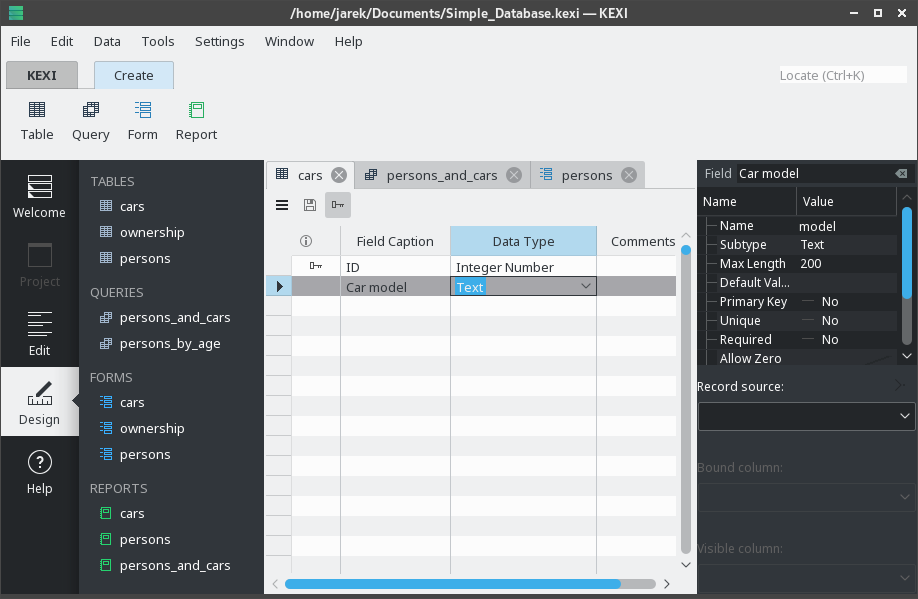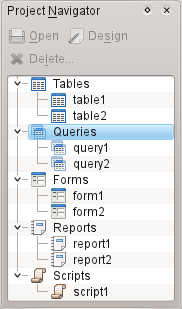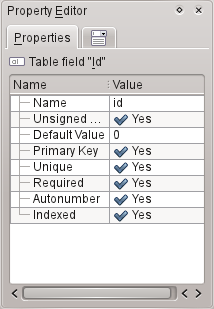Kexi/Handbook/Kexi Basics/The Kexi Main Window: Difference between revisions
No edit summary |
m (clarify phraseology) |
||
| Line 56: | Line 56: | ||
<!--T:51--> | <!--T:51--> | ||
Depending on the context, additional tabs | Depending on the context, additional tabs may be visible: | ||
<!--T:52--> | <!--T:52--> | ||
| Line 62: | Line 62: | ||
<!--T:53--> | <!--T:53--> | ||
* '''Report Design''' tab is visible if the Report Designer is actually in use. | * '''Report Design''' tab is only visible if the Report Designer is actually in use. | ||
====Project Navigator Pane==== <!--T:17--> | ====Project Navigator Pane==== <!--T:17--> | ||
Revision as of 19:05, 22 September 2014
The Kexi Main Window

The Tabbed Toolbar on the top gives access to common actions and commands.
The Project Navigator and Property Editor are shown in panes on each side of the child window. These can be resized or hidden as required. A pane can be hidden by clicking the small cross at the top of the pane (just below the toolbar).
Database objects (tables, queries, etc.) listed in the Project Navigator can be opened by clicking (or double-clicking, depending upon your global KDE settings) on their names.
Main Application Elements
Main elements of Kexi application's window are:
- Tabbed Toolbar
- Contains available commands for the application. You will find detailed description of any of the commands in Appendix C.
- Project Navigator pane
- Contains a list of any object (tables, queries, forms, ...) created within the currently opened database project. The navigator also contains a small toolbar with the most frequently used commands related to the database objects.
- Opened Database Objects Area / Tabbed Windows
- A central area of the application utilising most of the screen space. In IDEAl user interface mode it contains switchable tabs with windows that are always maximized. In Childframe user interface mode it contains floating windows.
- Property Editor pane
- Contains a list of properties of the currently selected database object. For certain objects (e.g. form widgets) it may have several tabs.
Tabbed Toolbar

The toolbar is the place that gives you access to most Kexi commands and actions. Using the actions found in the different tabs on the toolbar you can:
- Create / Open / Close Kexi projects
- Create Database objects
- Import / Export Data
Depending on the context, additional tabs may be visible:
- Form Design tab is only visible if the Form Designer is actually in use.
- Report Design tab is only visible if the Report Designer is actually in use.

The Project Navigator pane is one of the most frequently used elements of the Kexi main window. The pane contains a list of all objects created within the currently opened Kexi database project. The objects are split into groups: tables, queries, forms, reports and scripts.
The Project Navigator pane also contains a small toolbar for most frequently used commands (from left to right): selected object, selected object, and selected object.
For each object on the list a context menu is available using the right mouse button.
Double clicking with the left mouse button on the object's name on the list opens the object in Data View. If the object's window was already opened, the action just activates the window without switching it's view mode.
Opened Database Objects Area / Tabbed Windows

Whenever you double click an object in the project navigator, it opens in the Opened database objects area. Each window has its own tab in Kexi.
You can rearrange the tabs by drag and drop and close them using the ![]() button located at the far right of the tab strip.
button located at the far right of the tab strip.
Property Editor Pane

In the Property Editor pane you can change properties of the object displayed in the active window. Depending on the context, the pane is consisted of one or more tabs. The first, always visible tab, , contains the list of available properties.
Rules for using the Property Editor:
- Each row contains a single property.
- You can use the mouse or the keyboard to change values of particular properties.
- Most frequently used types of property values are:
- a number; you can enter the value directly or increase or decrease its value by clicking with the left mouse button on the arrows.
- text
- drop down list of values
- Yes/No; you can toggle the value by clicking on the button; Yes (true) means that the button is toggled on, No (false) means that the button is toggled off.
- Names of the recently changed properties that not yet were stored in the database are marked with bold text.
- After changing the value of a property, a special button appears on the right side of the Property Editor's list. By clicking it you can revert the value of the property to the original value that was loaded from the database upon opening the database object. The button is only visible when the property is actually highlighted.
The Property Editor pane is empty if:
- no single database object's window is opened, or
- the active database object's window does not offer properties; it is usually the case when it is opened in Data View instead of Design View.
